July 28 - August 3, 2013: Issue 121
Barrenjoey and Broken Bay Shipwrecks
The waters, shoals, island of Lion (formerly Mount Elliot), the headland and foothills of Barrenjoey are filled with the echoes of the souls of all who have been there. People who, with what’s in them, with works, created and Kept infrastructure that allows the human spirit to fly, in this case, on the water.
In reading the long list of all the vessels that have foundered in these waters a list grows with weekly and monthly entries dating back to the first recorded in 1803, and brings up visions of times when there were no life jackets, mere lines to shore if you were lucky, and life boats that capsized in the huge gale increased swells they were launched into or were smashed onto rocks unseen in darkness. It is a sad sad toll of souls who rest in this place, people who were seamen committed to transporting others to a new place and new hope, the families who travelled with them, and the growing teeming passageways up and down our coasts as a colony became a town and then a city with all a cities hungers for coal, for lumber, for food to feed all those who came. The gold rush of the 1850s brought more and those who could not strike it rich caught vessels to where work may be.
Some survived being shipwrecked, many did not.
Those who guarded their ways and rescued them when they could were the men and women placed in ‘stations’ up and down our coast. At Barrenjoey it was the Broken Bay Customs Station to begin with, whose officers and boat waiters first shone a light from at least 1855. A few years later the Barrenjoey Light Station came to be.
A ‘station’ by definition is ‘A place or position where a person or thing stands or is assigned to stand; a post: a sentry station; The place, building, or establishment from which a service is provided or operations are directed; (Historical Terms) (in British India) a place where the British district officials or garrison officers resided’ a place equipped for some particular kind of work, service, research, or activity’ From 1350–1400; Middle English stacioun; Anglo-French < Latin statiō a standing still, halting place =sta-, variant s. ofstāre to stand + -tiō -tion
In looking at Barrenjoey’s Light Keepers, who had to be married, with three men determined by law to be on each shift, The Head Light Keeper, the First Assistant and Second Assistant, whose wives and children were the telephonists, by telegraph, for shipping and weather reports, men who went out, as Customs and Light Stations officers to save others from 1843, and ‘Gales’ that brought mast bereft tides, and visions of ships, and people at water level and slipping under the dark briny, and the bombora that rolls between Barrenjoey and Lion Island in storm times, sometime even into the river Hawkesbury’s mouth, the count of Light Keepers, and where they came from and then went offers notes of joy amongst all the sad sad tolls. Lightkeepers families lived and were born and died here.
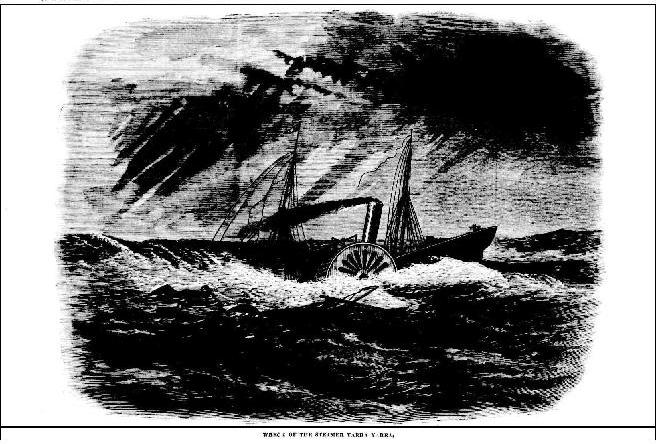 The ships, the
ships… the steamers, ferries, sloops, schooners, yachts, motor cruisers,
dinghies, long boats, whalers…are a long list of legendary names. Vessels that
were the first built in these waters, vessels that were the first brought out
from all other ports to fulfil the trade needs of a new nation that went
everywhere, mostly, on the water. Ships in increase making the run north, daily,
hourly, meant that every year and then every week or month there was someone to
be saved or logged as faring well for over 200 years.
The ships, the
ships… the steamers, ferries, sloops, schooners, yachts, motor cruisers,
dinghies, long boats, whalers…are a long list of legendary names. Vessels that
were the first built in these waters, vessels that were the first brought out
from all other ports to fulfil the trade needs of a new nation that went
everywhere, mostly, on the water. Ships in increase making the run north, daily,
hourly, meant that every year and then every week or month there was someone to
be saved or logged as faring well for over 200 years.
The count of these and where they floundered, some right under yon Light House, at Cape Three Points x 15, at Elliot/Lion Island x 5, at Flint and Steel x 9, those saved, those lost and ‘membered’ ever after in In Memorial Columns tides for ten years plus, can really only be 'reckoned' at.
And with these, and for those left to weep ashore, a counteracting Life Saving Tide rose in us. And a entity, a National Shipwreck Relief Society of New South Wales (later the Royal Shipwreck Relief & Humane Society of New South Wales society), that evolved to become the Royal Humane Society, and even Sailors Homes for all those who gave their livelihood, their all, to building a nation.
A vast number of our pioneers did not know how to swim. On our ships there were no life jackets, mere lines and clumsy life boats. When a demand for an increase in all materials, particularly coal sent south by overloaded steamer from Newcastle to Sydney, the watery environs around the light station, where small wallabies once gambolled, renders up all in her.
This week we shall list in chronological order a sample of those we can find records for up until 1900 and a little of these events and their people where we can. To list all would require many volumes and require full pages in some cases. Next Issue the Light Keepers, and their works, will remind us all of what a Light Station is about.
Our coastline is a graveyard for over 6,500 wrecked ships. That's one for every nine kilometres of coast. With the growing number of steamers travelling along our coasts the increase in shipping disasters also rose.
Newcastle itself, where all the coal came from, stems from a vessel being stolen by convicts from Broken Bay and their being pursued there. Since so many of the vessels wrecked near Barrenjoey may be attributed to Newcastle shipping lanes a record of this from those closer to these times:
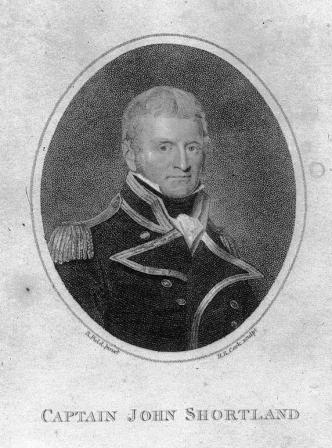 NEWCASTLE, the second
town of importance in New South Wales, situated at the mouth of the Hunter
River, was discovered by Lieut. John Shortland, of H.M.S.
"Reliance," in September, 1797, whose portrait we give in this number.
On the 16th September, 1797, when in pursuit of a boat called the
"Cumberland," stolen by some convicts, Lieutenant Shortland
discovered the Hunter River ; he also found coal close to the water's edge,
specimens of which he brought back with him to Sydney. Nothing of importance
followed on this discovery till April, 1804, when Newcastle was established as a
penal settlement for the colony, for second and third offences committed by
convicts sentenced at the Supreme Court, Sydney. The convict establishment was
first formed under the direction of a commandant—Chas. Throsby, Esq. In 1813,
Lieut Shotlowe, of the 73rd Foot, was the commandant. A flagstaff and coal
beacon were placed on the hill, where at present the residence of the Harbour
Master stands. Other buildings, such as a gaol, barracks, store, officers'
quarters, and a hospital, were progressed with as rapidly as possible, while
gangs of convicts were sent up the rivers Hunter, Paterson, and Williams, to cut
cedar and other timber. A breakwater was commenced between Nobby's and the
main-land, to give the worst characters employment. A coal shaft was sunk on the
present site of the market, and by these means over a thousand convicts were
kept profitably employed. Nobby's Island was used as a place of punishment for
refractory convict women, similar to Biloela, in Sydney. In 1814 Lieutenant
Thompson, of the 46th Foot, was commandant, succeeded by Captain Wallis, of the
same regiment, who effected several improvements during his term of office, and
erected several public buildings, amongst which may be mentioned that of Christ
Church, which was completed in 1821. In 1816, the Government colonial brig,
"Elizabeth Henriette," visited the port of Newcastle, and met
with an accident at her moorings in the harbour. She was upset, and two persons
were drowned. In 1818 Governor Macquarie paid the settlement a visit in the same
vessel, and inspected the public buildings and convict establishment. In 1819
the first vessel built on the Hunter—the "Princess
Charlotte"—was launched, and, in January, 1820, Commissioner Bigge, who
was sent out specially by the Home Government to enquire into the working and
expenditure of Governor Macquarie's Government, paid the town a visit, and was
much pleased and astonished at the discipline he found preserved under Major
Morriset's command. In December, 1821, Mr. Bingle visited Newcastle, in H.M.S.
Colonial sloop, "Sally," while on a voyage to examine the coast
survey between Sydney and Torres Straits. His reports of its capabilities were
considered so favourable, that Mr. Oxley, the Surveyor-General, was sent to
select and lay out the settlement. Shortly after this, in the following year,
the Hunter River was thrown open to free settlers, and soon the banks of the
Hunter, Paterson, and Williams, swarmed with free emigrants, and the hitherto
very stringent severity practised in the convict establishment was considerably
modified under Sir Thomas Brisbane’s Government. In 1823 Sir Thomas Brisbane
paid Newcastle a visit, in H.M.S. "Satellite," Captain Currie,
the first man-of-war that had yet visited the place. The Hunter River District
was meanwhile becoming populated with numerous respectable settlers from Great
Britain, who were arriving in Sydney with their goods and chattels ; and, to
provide for their wants, Mr. Bingle received permission from the Government to
build a vessel adapted to the trade, which was called the "Eclipse," and was
used expressly for the conveyance of passengers and the trade of the port. The
first two town allotments were granted to Mr. Bingle and his partner, Mr.
Dillon, and surveyed by Mr. Henry Dangar. In 1829 the "Eclipse" was run
away with by a gang of convicts. The trade was carried on by
the cutter "Lord Liverpool," until 1833, when the
steamers "Sophia Jane" and "Tamar," from Tasmania, commenced a daily
trade between Sydney, Newcastle, and Morpeth. A company was formed, called the
"Australian Company," and they bought the "William IV." which they added to the
fleet, and carried on the trade till this company was merged into the A.S.N.
Co., established in 1841. In 1844 the Hunter River Steam Navigation Company was
formed, and they brought into the trade three other boats, which divided the
trade with the A. S. N. Company. The name of the town itself originated with the
settlers, who thought it appropriate, on account of the coal deposits. Up to the
year 1827 the Government were the sole producers of coal, but in that year they
handed over the whole of their vested interest to the A. A. Company, who at once
commenced operations. A pit was sunk on the hill, at the back of the present
loading staiths. A temporary shipping place, where vessels could load by means
of an inclined plane, was constructed, and a wooden bridge was built, to cross
the road, a little to the eastward of the present one, which was built in 1862.
The English Government granted the Company a large area of land, and a monopoly
on the production of coals, which was the cause of much complaint. The
mono-poly, however, was terminated in 1851 or 1852, by an action in the Supreme
Court. The pit called the A pit was worked for many years, and others were sunk,
in proportion to the increase of trade. No. 2 pit produces 600 tons of the best
screened coal every working day. The late Dr. Mitchell owned a considerable
portion of the adjoining property, and discovered the richness of its coal
deposits, and that they could be worked at a trifling cost, without sinking.
Messrs. Donaldson and Brown rented a portion of Dr. Mitchell's estate, for the
purpose of supplying coal to the shipping in the harbour, and sold their
interest to the Coal and Copper Company, which commenced operations in 1853. By
mismanagement their funds were soon exhausted, and the Company wound up, the
plant falling hack into Dr. Mitchell’s hands, in 1862. The Scottish Australian
Company was then formed, and has been successful. Other companies were formed
since, in Sydney, which have all succeeded, more or less. The following returns
show the enormous progress made during the last quarter of a century.
NEWCASTLE, the second
town of importance in New South Wales, situated at the mouth of the Hunter
River, was discovered by Lieut. John Shortland, of H.M.S.
"Reliance," in September, 1797, whose portrait we give in this number.
On the 16th September, 1797, when in pursuit of a boat called the
"Cumberland," stolen by some convicts, Lieutenant Shortland
discovered the Hunter River ; he also found coal close to the water's edge,
specimens of which he brought back with him to Sydney. Nothing of importance
followed on this discovery till April, 1804, when Newcastle was established as a
penal settlement for the colony, for second and third offences committed by
convicts sentenced at the Supreme Court, Sydney. The convict establishment was
first formed under the direction of a commandant—Chas. Throsby, Esq. In 1813,
Lieut Shotlowe, of the 73rd Foot, was the commandant. A flagstaff and coal
beacon were placed on the hill, where at present the residence of the Harbour
Master stands. Other buildings, such as a gaol, barracks, store, officers'
quarters, and a hospital, were progressed with as rapidly as possible, while
gangs of convicts were sent up the rivers Hunter, Paterson, and Williams, to cut
cedar and other timber. A breakwater was commenced between Nobby's and the
main-land, to give the worst characters employment. A coal shaft was sunk on the
present site of the market, and by these means over a thousand convicts were
kept profitably employed. Nobby's Island was used as a place of punishment for
refractory convict women, similar to Biloela, in Sydney. In 1814 Lieutenant
Thompson, of the 46th Foot, was commandant, succeeded by Captain Wallis, of the
same regiment, who effected several improvements during his term of office, and
erected several public buildings, amongst which may be mentioned that of Christ
Church, which was completed in 1821. In 1816, the Government colonial brig,
"Elizabeth Henriette," visited the port of Newcastle, and met
with an accident at her moorings in the harbour. She was upset, and two persons
were drowned. In 1818 Governor Macquarie paid the settlement a visit in the same
vessel, and inspected the public buildings and convict establishment. In 1819
the first vessel built on the Hunter—the "Princess
Charlotte"—was launched, and, in January, 1820, Commissioner Bigge, who
was sent out specially by the Home Government to enquire into the working and
expenditure of Governor Macquarie's Government, paid the town a visit, and was
much pleased and astonished at the discipline he found preserved under Major
Morriset's command. In December, 1821, Mr. Bingle visited Newcastle, in H.M.S.
Colonial sloop, "Sally," while on a voyage to examine the coast
survey between Sydney and Torres Straits. His reports of its capabilities were
considered so favourable, that Mr. Oxley, the Surveyor-General, was sent to
select and lay out the settlement. Shortly after this, in the following year,
the Hunter River was thrown open to free settlers, and soon the banks of the
Hunter, Paterson, and Williams, swarmed with free emigrants, and the hitherto
very stringent severity practised in the convict establishment was considerably
modified under Sir Thomas Brisbane’s Government. In 1823 Sir Thomas Brisbane
paid Newcastle a visit, in H.M.S. "Satellite," Captain Currie,
the first man-of-war that had yet visited the place. The Hunter River District
was meanwhile becoming populated with numerous respectable settlers from Great
Britain, who were arriving in Sydney with their goods and chattels ; and, to
provide for their wants, Mr. Bingle received permission from the Government to
build a vessel adapted to the trade, which was called the "Eclipse," and was
used expressly for the conveyance of passengers and the trade of the port. The
first two town allotments were granted to Mr. Bingle and his partner, Mr.
Dillon, and surveyed by Mr. Henry Dangar. In 1829 the "Eclipse" was run
away with by a gang of convicts. The trade was carried on by
the cutter "Lord Liverpool," until 1833, when the
steamers "Sophia Jane" and "Tamar," from Tasmania, commenced a daily
trade between Sydney, Newcastle, and Morpeth. A company was formed, called the
"Australian Company," and they bought the "William IV." which they added to the
fleet, and carried on the trade till this company was merged into the A.S.N.
Co., established in 1841. In 1844 the Hunter River Steam Navigation Company was
formed, and they brought into the trade three other boats, which divided the
trade with the A. S. N. Company. The name of the town itself originated with the
settlers, who thought it appropriate, on account of the coal deposits. Up to the
year 1827 the Government were the sole producers of coal, but in that year they
handed over the whole of their vested interest to the A. A. Company, who at once
commenced operations. A pit was sunk on the hill, at the back of the present
loading staiths. A temporary shipping place, where vessels could load by means
of an inclined plane, was constructed, and a wooden bridge was built, to cross
the road, a little to the eastward of the present one, which was built in 1862.
The English Government granted the Company a large area of land, and a monopoly
on the production of coals, which was the cause of much complaint. The
mono-poly, however, was terminated in 1851 or 1852, by an action in the Supreme
Court. The pit called the A pit was worked for many years, and others were sunk,
in proportion to the increase of trade. No. 2 pit produces 600 tons of the best
screened coal every working day. The late Dr. Mitchell owned a considerable
portion of the adjoining property, and discovered the richness of its coal
deposits, and that they could be worked at a trifling cost, without sinking.
Messrs. Donaldson and Brown rented a portion of Dr. Mitchell's estate, for the
purpose of supplying coal to the shipping in the harbour, and sold their
interest to the Coal and Copper Company, which commenced operations in 1853. By
mismanagement their funds were soon exhausted, and the Company wound up, the
plant falling hack into Dr. Mitchell’s hands, in 1862. The Scottish Australian
Company was then formed, and has been successful. Other companies were formed
since, in Sydney, which have all succeeded, more or less. The following returns
show the enormous progress made during the last quarter of a century.
Tons.
Value.
In 1849 the total Coal raised was ... 48,500 £14,000
1857, ;
210,400 148,200 1872, ; 858,716 340,973, 1873, ; 1,014,233 581,801
The
principal street in Newcastle is Hunter-street, parallel to which are
King-street and Church-Street, crossed at right angles by Pacific-street,
Watt-street, Newcombe-street, and other small streets, of no importance. Most of
the principal buildings in the town are situated in Hunter-street, which forms
the leading business thoroughfare. Cross streets lead down to the wharves and
shipping. NEWCASTLE. (1875, April 8). Illustrated
Sydney News (NSW : 1853 - 1872), p. 2. Retrieved from http://nla.gov.au/nla.news-article63105285
Image: Captain John Shortland, 1889 (photographic copy), image No: gpo1_06405, courtesy State Library of NSW.
Although vessels were lost prior to this date, the first recorded shipwreck in the waters around Barrenjoey stems from 1803.
This was a wooden sloop named John, Captain T. Williams and was the first of two sloops of this same name owned by John Palmer, who was originally the purser on the Sirius the flagship of the First Fleet, arrived in NSW on January 26th, 1788. The John capsized in Broken Bay on the 22nd of May 1803 while carrying wheat from the Hawkesbury to Sydney when forced to anchor in bad weather. A hawser snapped, forcing her to stand out from the shore, but she capsized in Broken Bay, at Flint and Steel Bay. The crew of four were saved.
 John Palmer
(17 June 1760 - 27 September 1833 ,aged 73), was appointed Commissary General of
New South Wales on 2 June 1791. In this post he was responsible for the
reception and issue of all government stores, virtually the only supplies in the
colony, and their supplement by purchase from private merchants. Palmer received
his first land grant of 100 acres (40 ha) in 1793 which he named Woolloomooloo
Farm. Here he planted an extensive orchard, built one of the colony's first
permanent residences, and elegantly entertained the first rank of colonial
society. In 1795 he was described him as one of the three principal farmers and
stockholders in the colony. In 1803 Palmer was hailed as the first exponent of
improved farming methods when he reduced the men employed on his 300-acre (121
ha) Hawkesbury farm from a hundred to fifteen. Also by 1803 he owned several
small colonial-built craft. When he died at Waddon near Parramatta on 27
September 1833, he was 'the last surviving officer of the first fleet that
arrived in this part of His Majesty's Dominions'. (1.)
John Palmer
(17 June 1760 - 27 September 1833 ,aged 73), was appointed Commissary General of
New South Wales on 2 June 1791. In this post he was responsible for the
reception and issue of all government stores, virtually the only supplies in the
colony, and their supplement by purchase from private merchants. Palmer received
his first land grant of 100 acres (40 ha) in 1793 which he named Woolloomooloo
Farm. Here he planted an extensive orchard, built one of the colony's first
permanent residences, and elegantly entertained the first rank of colonial
society. In 1795 he was described him as one of the three principal farmers and
stockholders in the colony. In 1803 Palmer was hailed as the first exponent of
improved farming methods when he reduced the men employed on his 300-acre (121
ha) Hawkesbury farm from a hundred to fifteen. Also by 1803 he owned several
small colonial-built craft. When he died at Waddon near Parramatta on 27
September 1833, he was 'the last surviving officer of the first fleet that
arrived in this part of His Majesty's Dominions'. (1.)
Image: Dockyard ship building (courtesy Ellis Luciano Silas
1883-1972)
The Sirius had been converted from a merchantman, Berwick. The Berwick was likely built in 1780 by Christopher Watson and Co. of Rotherhithe, who also built another ship of the first fleet, the Prince of Wales. She had a burthen of 511 83⁄94 tons and, after being burnt in a fire, was bought and rebuilt by the Royal Navy in November 1781, retaining her original name. Between September and December 1786 she was fitted for service with the First Fleet and on the 12 October 1786 Berwick was renamed Sirius, after the southern star Sirius. The Sirius sailed under the command of Captain John Hunter and carried Captain Arthur Phillip, who would be the first governor of the new colony. She also carried Major Robert Ross, commander of the Royal Marines who would be responsible for providing security for the colony. When Botany Bay was found to be unsuited to supporting a penal colony she helped move the new settlement to Sydney Cove, Port Jackson, arriving January 26th, 1788. it was also the Sirius who made a mercy dash to South Africa in October 1788, returning seven months later with supplies that saved the starving fledgling colony. Coincidentally on 19 March 1790, the Sirius was wrecked on a reef at Norfolk Island while landing stores. (2.)
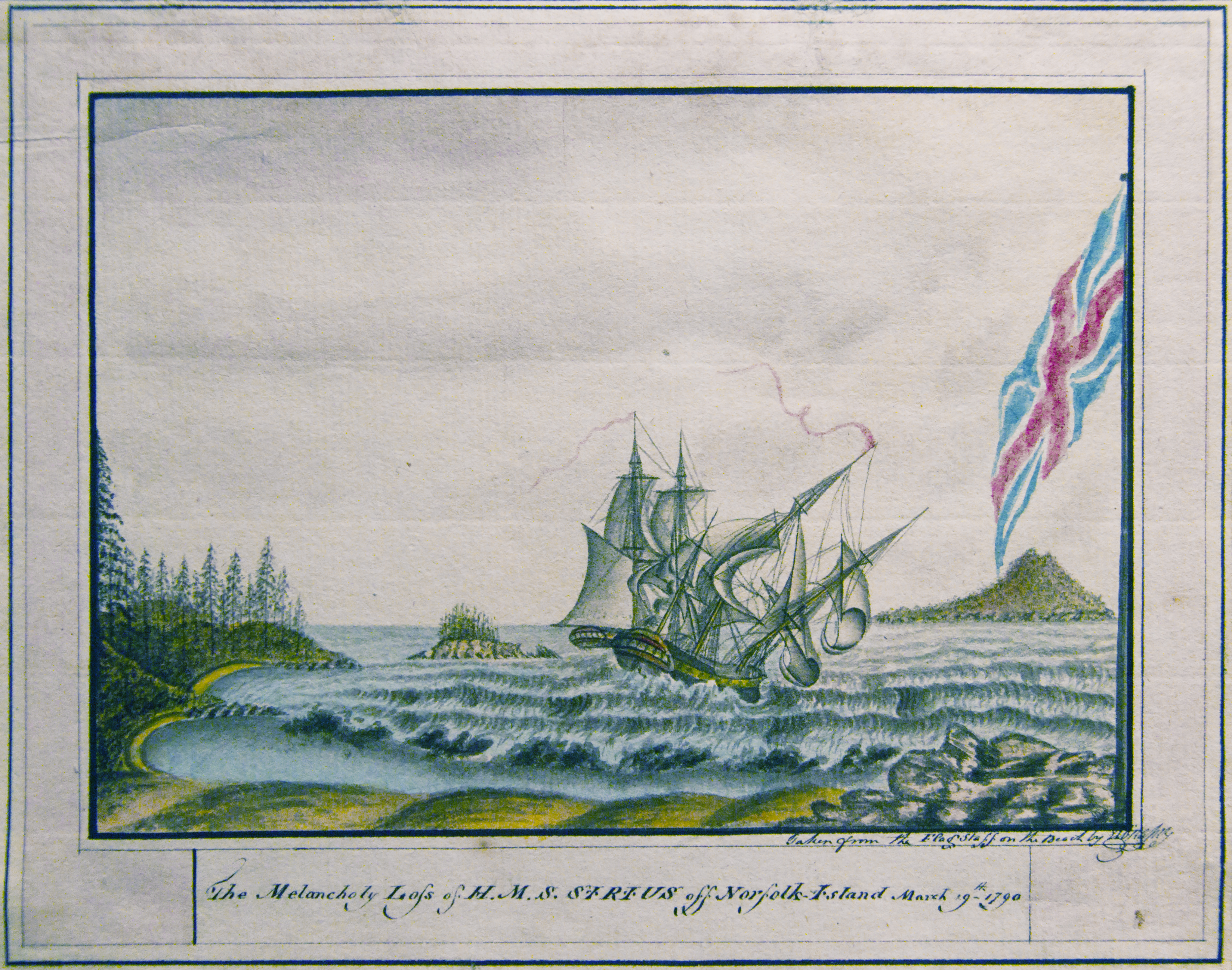
The melancholy loss of HMS Sirius off Norfolk Island March 19th 1790 - George Raper, courtesy National Library of Australia, Image No: an21511971. The only authentic pictures of theSirius which are known are a dozen beautiful small watercolour sketches by her first Lieutenant, William Bradley, drawn at various intervals during the voyage, and contained in his journal, now in possession of the Mitchell Library.
Next the Speedwell a sloop of 18 tons owned by Andrew Thompson who named Scotland Island, ran aground in a creek near Mt.Elliot, Broken Bay, NSW, 14 October 1804; and was refloated 5th of December.
Andrew Thompson was the master and/or owner of several ships in NSW in the years 1802-1807. Some of his ships (and the years in which they were registered) were the Hope, (1802); Hawkesbury, (1804); Hope of Hawkesbury, Nancy, and, in 1807, the Governor Bligh. Andrew Thompson died in 1810 at the age of 37, some sources state as a result of the after effects of saving so many in the Hawkesbury Floods of 1809.
Broken Bay and Pittwater were considered a safe harbour from gales during this time and many vessels fill the records with staying in this ‘second port’ during these first centuries of New South Wales:
The Ann, Captain Gwynn, and Ann and Eliza, Captain Gardner, remain in Broken Bay. SHIP NEWS. (1805, November 3). The Sydney Gazette and New South Wales Advertiser (NSW : 1803 - 1842), p. 2. Retrieved from http://nla.gov.au/nla.news-article626955
The third, fourth and fifth vessels on record as being wrecked in the watery environs of near or below Barrenjoey occurred during one of the many gales that took lives and vessels:
On Thursday a boat came in from Broken Bay,
with the melancholy information of the total loss of the
Argument, Pate (Benjamin Pate (3.) ), loaded in wheat from Hawkesbury,
and the death of all the persons onboard, comprising Pate himself, a woman of
the name of Mary Kirk, and James Dicey, Pate's boat assistant. Their bodies were
found about the short reef, nearly four miles from the Heads of Broken Bay, and
interred on the morning of Thursday last. We last week mentioned her
sailing out of Pittwater in company with the Hazard and Experiment, the
latter of which got safe in the 17th ultimo, without being able to give any
further account of the above vessel than that they lost sight of her in a heavy
squall on the Sunday previous. The conjecture therefore is that Pate, although
well experienced in this navigation, had in the dark, mistaken the short
reef for the entrance of Broken Bay, whither he thought it prudent to
return; but unfortunately this mistake proved fatal.—The vessel was dashed to
pieces.
Another small colonial vessel, the property of Daniel
McLeese, laden with lime, has since also been lost near the same place,
but no lives lost. The Hazard, belonging to Messrs. Thorley and
Griffiths, which got ashore at Box Head, has been got off, with
the loss of her whole freight of wheat. SHIP NEWS. (1809, April
2). The Sydney Gazette and New South Wales Advertiser (NSW :
1803 - 1842), p. 1. Retrieved from http://nla.gov.au/nla.news-article627714
The wooden sloop Experiment was later destroyed in another gale when she was driven ashore on the south-east arm of Broken Bay, 12 March 1818, this time no lives lost.
Endeavour. Wooden schooner, 50 tons. Built c1809. Lost off
Broken Bay, 12 June 1825
The
schr. Endeavour got on shore at Broken Bay Sunday week. A report
reached Town on Saturday, by one of the Five Island boats, that the wreck of a
vessel was seen by some natives, between the Pigeon-house and Jarvis' Bay, about
ninety miles, to the Southward of Sydney. At first it was supposed to be the
Eclipse and one of the owners was preparing to go down in a whale boat, to learn
the particulars ; but in tracing the report ; to its foundation, the wreck was
found to be that of a smaller vessel than the Eclipse. All the crew have, been
killed by the natives, who have possession of some muskets that belonged to her.
It is said that she has been wrecked more than three or four months since;
it also is supposed to be the vessel which belonged to Thomas Street,
and which was taken away from Broken Bay, some time back. No
title. (1825, June 23). The Australian (Sydney, NSW :
1824 - 1848), p. 2. Retrieved from http://nla.gov.au/nla.news-article37073067
Sometimes only remnants of what was on board came into shore
as in the case of the Elizabeth, a wooden two masted brig of 130
tons. Built NSW, 1821-1822; reg. Sydney 7/1829. Lbd 61.3 x 19 x 10 ft.
Built Hawkesbury River, 1821. Sailed from Launceston for Sydney 24
November 1829 and never seen again. Wreckage was found
on the coast between Sydney and Newcastle in May 1830, and mail was
washed ashore in Broken Bay. (4.)
The cutter Linnet, 10 tons, belonging to Mr. Marks, of Sydney, was totally wrecked last week in Broken Bay, and the whole of her cargo lost. Her anchors, cable, and part of her rigging, were all that could be saved from her. DOMESTIC INTELLIGENCE. (1834, April 28). The Sydney Herald (NSW : 1831 - 1842), p. 2. Retrieved from http://nla.gov.au/nla.news-article12849207
The difficulty in finding all these vessels is that many were named the same and the tonnage and type must be scrutinised. Two other ‘Linnet’ vessels existed in this same year, one for sale at Plymouth as an ex-ship of war of British origin with 10 guns and of 237 tons, and another a brig of 112 tons that was bringing people to Australia. Just one listing of all those going up the coast from Sydney or arriving names yet another past this shipwreck;
Coastwise.— Inwards 13; tons, 403: Viz; Lambton, Shamrock, John, Sophia Jane, Nancy, Glatton, Mary Ann, Linnet, Emma Kemp, Red Rover, Monitor, Emma,. Abcona. Outwards 10; tons, 435; viz — Brisbane, Betsy, Redpole, Caledonia, Fanny, Experiment, Shamrock, John, Sophia Jane, Glutton, Lambton, Edward, Northumberland, Lord Liverpool, Nancy, Linnet. SHIP NEWS. (1831, July 29). The Australian (Sydney, NSW : 1824 - 1848), p. 3. Retrieved from http://nla.gov.au/nla.news-article36866167
Competition to carry more and more coal faster and faster to Sydney claimed a few casualties in the ensuing decades. The first of these we can find a record of is the Denmark Hill, a wooden three-masted barque, of 253 tons. Reg. Sydney, 43/1838. Lbd 91.6 x 25.6 x 5.4 ft. Captain Clements. The Denmark Hill regularly traded between England, Port Jackson and Hobart and is recorded landing ‘merchandise’ at Hobart as early as 1822. The Encyclopaedia of Australian Shipwrecks states this vessel’s wreckage caused the sinking of the wooden cutter Rover, three years later:
THE DENMARK HILL. The ship Denmark Hill, Captain Clements, the property of Mr J. S. Brown, while lying at Newcastle for the purpose of taking in coals, a few days since took the ground, and went over on her broadside, but she was righted, without, as was supposed having received any material damage. She put to sea for the purpose of coming on to Sydney on Thursday morning, then leaning considerably and a few hours after she had cleared Nobby's Island, a fresh leak was sprung and the pumps got choked with coals. The pumps were hoisted upon deck and cleared, and upon endeavouring to replace them, Captain Clements found the coals had shifted and blocked up the well and that it was impossible to do so. As the water was gaining fast on them, the vessel was run under the lee of Bird Island, about thirty miles from Newcastle, where the anchor was let go in the hope of being able to stop some portion of the leaks. A little after four o'clock the Sophia Jane steamer, from Newcastle bound to Sydney hove in sight, when the captain of the Denmark Hill gave orders to slip the cable, make sail on the vessel, and stand in the course of the steamer, in order to obtain assistance. About six o'clock the Sophia Jane came up, when the Captain of the Denmark Hill informed Captain Griffin that she had then five feet water in the hold, and as the leak was increasing he requested Captain G. to stay by them that night, us he did not expect the vessel would keep afloat till morning. The wind at that time falling light, and there being every appearance of a westerly breeze setting off the land in the night, Captain Griffin thought it advisable to tow the Denmark Hill into Broken Bay, to which Captain Clements consented, and at the same time requested that the vessel might be laid on some beach inside the harbour, where she would ground. Captain Griffin immediately ordered the warps to be got aft, and the boats to be lowered down for the purpose of running them on board the Denmark Hill, then tying astern with her main top-sail aback. The ends of the warps were taken onboard and made fast, during which time the steamer had drifted to leeward of the Denmark Hill, which occasioned the warps to hang in a bight ;and the boat returning from the Denmark Hill to the steamer, for the purpose of getting hold of a towline hanging over the stern, Captain Griffin was unable for some time to gather headway upon the steamer, lest the warps should come in contact with the boat and capsize her; nor did he do so until the Denmark Hill was close on board of the steamer. On nearing, the jib boom of the Denmark Hill carried away the main-mast head of the steamer, and her own jib boom and foretop mast head, the foretop-gallant mast and yard the same time going over the side, and the fore topsail yard, falling on the cap, was carried away the bunt and fell on deck. Capt. Griffin was compelled for the safety of the steamer to make some headway, in doing which the warps became a little tighter, and the men in the boat, in order to clear themselves, passed the warp over their heads, which unfortunately occasioned the boat to capsize, and two of the men were precipitated into the water; the other (the mate of the steamer) succeeded in saving himself by clinging to the tow-rope over the stern, by means of which he got onboard. A boat from the Denmark Hill was immediately lowered, but before it could reach the unfortunate men they were drowned. There was a very heavy swell on, which carried away the warps by which the Denmark Hill is being towed, several times, but Captain Griffin got a third one on board, and succeeded, in reaching the entrance of Broken Bay about three o'clock on Friday morning, at which time Captain Clements hailed him again, to enquire how long it would be before he could run his vessel on shore as she was settling down fast and the water was then up to her between-deck beams, and on being told about an hour, he replied, "It is not possible she can keep up above half an hour longer". Finally, however, they succeeded in grounding her on a sandy beach between Barrenjoey and the mainland, where she now lies. The Sophia Jane did not arrive in Sydney till seven o'clock on Friday morning. SHIP NEWS. (1839, April 29). The Sydney Herald (NSW : 1831 - 1842), p. 2. Retrieved from http://nla.gov.au/nla.news-article28653656
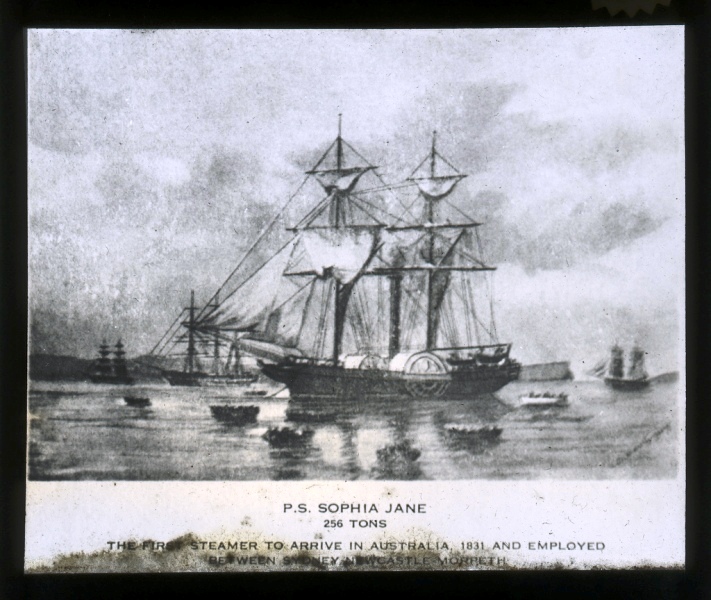
Sophia Jane, original plate, 1841.
A few years later the continuous smuggling Pittwater and Broken Bay had become renowned for caused an investigation, a finding of contraband spirits, and the opening of the Broken Bay Customs Station in 1843:
SYDNEY.ANOTHER SEIZURE BY THE WATER POLICE. — On Sunday afternoon Capt. Brown, received information that some casks of contraband spirits were concealed along the coast, and he immediately commenced operations for their capture. The water-police schooner Ariel got under weigh about eleven o'clock at night, and, having cleared the heads, proceeded in a northerly direction until day-break, when the spot was pointed out where the goods were last seen — a small sandy beach on the sea shore. The sea was breaking heavy on it at the time, and it was therefore deemed necessary by the captain (Mr. Drew) to come to an anchor beside the Sandpit at Pittwater, whence they walked overland to the beach, well armed, and having implements for digging, &c. After probing the sand in different places, they at length succeeded in finding five hogs-heads of brandy buried under it. The schooner at this time was lying about two miles off, and the only method of getting the casks on board was by rolling them over about two miles of dead sand. This was accomplished with difficulty. It is supposed that these five casks are part of those landed at the Hawkesbury. The schooner returned to port on Tuesday afternoon, and as no commission from the customs is now held by the water police, Captain Brown gave information of the seizure to the Collector of Customs, who will of course enjoy all the advantages derived from the vigilance and activity of Captain Brown. SYDNEY. (1842, September 10). Launceston Examiner(Tas. : 1842 - 1899), p. 6 Edition: MORNING. Retrieved August 1, 2012, from http://nla.gov.au/nla.news-article36249884
On November 3rd,
1842 the Rover, a wooden cutter of 10 tons, built Hawkesbury River,
1839; reg. Sydney, 86/1840. Lbd: 26 x 10.5 x 4.5 ft was lost after striking the
hull of the Denmark Hill, Pittwater, Broken Bay, NSW, 3 November 1842. No loss
of life. She was carrying a cargo of lime from Pittwater to Sydney, which became
saturated when the vessel sank, and burst her sides. (4.)
Brothers;
wooden cutter, 11 tons. Built Hawkesbury River, NSW 1840; reg. Sydney,
75/1842. Lbd 25.6 x 10.2 x 4.9 ft. Traded between Sydney and Hawkesbury River.
Capsized whilst attempting to shelter in Broken Bay in a gale, October
1845. (4.)
Eliza Ann; built Manning River, NSW, 1841; reg. Sydney, 2/1847. Her original size appears to be 32 tons, lbd 41 x 14.4 x 7 ft, but appears she was altered to lbd 56.7 x 14.5 x 6.4 ft. Captain Hunter. From Sydney to Richmond River, drifted ashore and lost near Broken Bay, NSW, south of Barrenjoey lighthouse, 19 October 1847; one of four crew lost. (4.)
The report of the loss of the schooner Eliza Ann has been confirmed, by the arrival of two of the seamen from Broken Bay. It appears she left the Heads about five o'clock on Tuesday afternoon, for the Richmond River, with a light south-east wind, during the evening it veered more east, and about twelve o'clock altogether died away. She was then a few miles this side of Broken Bay, and being close in shore, the heavy swell drove her on to the rocks, where she became a total wreck. The crew were three seamen on board, besides the master (Hunter), and a passenger; one of the former, we are sorry to state, was drowned, and the master very severely injured in getting up the rocks, so much so that he still remains at Broken Bay, being unable to come on to Sydney. The Eliza Ann was a schooner of 45 tons register, and the property of Mr. Garrison, of Lower George-street. PORT PHILLIP. (1847, October 23). The Sydney Morning Herald (NSW : 1842 - 1954), p. 2. Retrieved from http://nla.gov.au/nla.news-article12896386
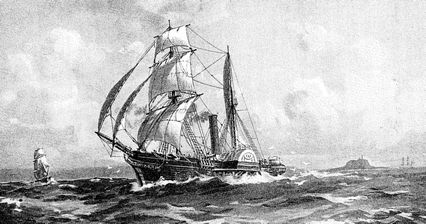 We have been informed that one boat only, on
her way hence to Broken Bay, was lost a short time ago. One man was
drowned, in the instance alluded to. The Thistle left Newcastle
for Sydney on Saturday morning, and had proceeded as far as Broken Bay,
when she was compelled to bear up again inconsequence of the heavy gale from the
south- west, and arrived at Newcastle at midnight. LAUNCESTON.
(1848, July 12). The Sydney Morning Herald(NSW : 1842
- 1954), p. 2. Retrieved from http://nla.gov.au/nla.news-article12908349
We have been informed that one boat only, on
her way hence to Broken Bay, was lost a short time ago. One man was
drowned, in the instance alluded to. The Thistle left Newcastle
for Sydney on Saturday morning, and had proceeded as far as Broken Bay,
when she was compelled to bear up again inconsequence of the heavy gale from the
south- west, and arrived at Newcastle at midnight. LAUNCESTON.
(1848, July 12). The Sydney Morning Herald(NSW : 1842
- 1954), p. 2. Retrieved from http://nla.gov.au/nla.news-article12908349
The Thistle was one of three vessels(Rose and Shamrock) brought out from by the Hunter River Steam Navigation Co. to meet the rising demand of passenger services and transporting goods. She arrived April 22nd 1841 and was 278 gross tons, 175 net. Her Length breadth, depth: 148'7" x 19'5" x 11'0". Iron paddle steamer, schooner rigged Built by William Fairburn & Co, Poplar London 1840. Came to Australia arriving 22 April 1841, 130 days out from England. Thistle 1841 illustration from "The Newcastle Packets and the Hunter Valley" by J.H.M.Abbott, (Sydney 1942), facing p84. Courtesy of the State Library of Queensland
Rose of Eden. Wooden schooner, 50 tons. Built NSW, 1848; reg. Sydney, 87/1849. Length 57.8 ft. Lost in bay between Broken Bay and Barranjoey heads; ashore south of Broken Bay, NSW, July 1852. Homeward bound from Macleay River with a cargo of tallow, hides and furniture; all passengers and crew lost. (4.)
To the Editors of the Sydney Morning Herald. Gentlemen, I see by this morning's Herald, in which you report the loss of the schooner Rose of Eden, between Sydney and Broken Bay, that you state that W. H. Chapman, Esq., is the owner of the schooner ; and from the account given of the cargo, that the greater part of it belonged, to Mr. Chapman also. I beg to state most distinctly that the vessel does not belong to Mr. Chapman, neither does the cargo, with the exception of a very small portion, if any. With regard to the passengers, I beg to say from a letter I received from Mrs. Chapman, dated the 10th instant, that lady states that Mrs. Miss, and Master Wilson, were passengers by that unfortunate vessel, with several others whose names I do not know. I am, Gentlemen, yours, obediently, WM. DALTON Agent for Mr. Chapman. Sydney, June 25. To the Editors of the Sydney Morning Herald. (1852, June 26).The Sydney Morning Herald (NSW : 1842 - 1954), p. 4. Retrieved from http://nla.gov.au/nla.news-article12937928
Wreck of the Rose of Eden.-information has reached Sydney respecting the total wreck of this schooner, on the Little Reef, to the southward of South Head, of Broken Bay. The Rose of Eden was the property of Mr. W. H. Chapman. She was homeward bound, from the M'Leay. River, with a cargo of tallow and hides; a great portion of the tallow was washed ashore, together with some pieces of furniture and wearing apparel. Report states that she had, in-addition to her own crew and passengers, the crew of another vessel stranded on the bar of the M'Leay River; as yet, it is impossible to give a list of their names. Not a single trace could be found of any of the people of the Rose of Eden, and it is to be feared that all on board her met with an untimely death. Seventy-one casks or tallow have been secured. No doubt all on board perished and the bodies have been swept out to sea.- S. M. Herald. Miscellaneous. (1852, July 17). Launceston Examiner (Tas. : 1842 - 1899), p. 7 Edition: AFTERNOON. Retrieved from http://nla.gov.au/nla.news-article36263581
The coasts then, as now, were a wilderness with no Voluntary Coastal Patrol and although the Customs Station men would put to sea to save those who they could when they could, so many vessels disappeared, with their passengers and crew, never to be seen again. One interesting article found during research offers some 'Broken Bay' explanations:
"Barrier:" The coast dingoes are not so plentiful as of old. An occasional shipwreck brings them to the beach in quest of a sheep's carcase, or whatever the tide brings in or smashes against the rocks. But the dingo has never learned to keep the safe side of a shark's dinner. One midnight, while camped I with a party of fisherman, below Broken Bay we discerned a piece of whale beef, about 10 feet square, drifting towards the rocks. It had evidently become detached from a big ‘kill' higher up the coast. It was an ancient bit of whale, and the odour was strong enough to fight a battleship. In the darkness we saw a swarm of sharks tearing and rending the edge to fragments. As each monster swirled unto the floating mass, a sound like the splitting of timber followed, as the big snouts ripped bone and fat asunder. The smell of the whale junk grew violent as the struggle continued; we decided to shift camp to the cleaner atmosphere beyond the sandhills. An hour before dawn I strolled along the beach, to recover some nets left within reach of the rising tide. Turning the angle of the cliff, I saw a pack of dingoes skirmishing from point to point towards the strong-smelling whale heap. The tide had lifted it almost to the rocks, and the dingo leader, an old brown and black ruffian, seemed in a dreadful hurry to get to business. The dingo is not a water dog, but he will risk wetting his feet to snatch at a bit of rich meat and bone. The pack trotted to tho water’s edge, and yelped at the In-driving whale junk. The leader sniffed hungrily, then measured the distance carefully, and sprang to the oval shaped mass. He landed square in the centre, but his feet slipped on the greasy hide, and with a penetrating yell he vanished in the water. A terrific commotion followed, as though the school of sharks were sampling an underfed sheep-stealer. A gentle silence followed, as the dingo pack glared hungrily and suspiciously at the blood-smeared waters around the In-rushing whale beef. A loan, white-chested …. took the next jump, and she clung with mouth and toes to the spongy, oily mass. Her sudden appearance on the junk of beef seemed to enrage tho monsters underneath. With the cunning of horse thieves, they began dragging their spoil Into deeper water. It moved slowly, as though they were hauling It from beneath. The …. seemed to realise her position. She clung to the outgoing mass, with hair bristling about her neck and shoulders. The pack on shore howled dolefully, and requested her to come home and study navigation before going to sea. A sudden wave swung the whale beef skyward, and Mrs. Dingo disappeared with a great splash. The wild dog is only a new chum when it comes to stealing a shark's breakfast. BY THE WAY. (1906, June 6). Australian Town and Country Journal (NSW : 1870 - 1907), p. 28. Retrieved from http://nla.gov.au/nla.news-article71531016
To save lives methods were explored:
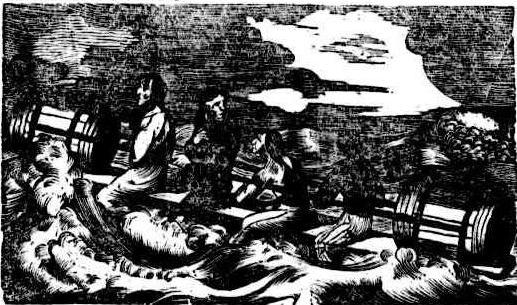 SHIPWRECK. In cases of
shipwreck, upon reefs unconnected with the main land or islands, it not
unfrequently happens that the vessel's boats afford little chance of
preservation for the crew. From the nature of their construction, they are ill
calculated to be managed
SHIPWRECK. In cases of
shipwreck, upon reefs unconnected with the main land or islands, it not
unfrequently happens that the vessel's boats afford little chance of
preservation for the crew. From the nature of their construction, they are ill
calculated to be managed
successfully in broken water. The risk, likewise, is
very great in getting them over a vessel's side, ina situation of danger, and it
is seldom that after along passage they are in a fit state for service. A
plan(which, for its simpleness and easy construction, deserves the attention of
mariners), once afforded a friend of the writer and three or his crew, the means
of preservation from shipwreck on a reef seven miles from the main. The
boats, in which the remainder of the crew had attempted to reach the shore, were
swamped in the attempt, when an old sailor, (the ship having parted in
midships), proposed rigging a raft, (a description of which is
roughly attempted underneath), which was complete} and afloat in less than
fifteen minutes. It consisted of a broad plank, upon which a cask was lashed
with two pair or slings at each end. A rope passed from one cask to the
other, and, seized on to the slings, secured them to their places, and
formed a life rope, between which the luckless passengers sat with the utmost
security. Although the raft passed over several reefs, on which the sea broke
with terrific violence, and was several times capsized, it as often regained
its correct position, and ultimately reached a beach upon the main. It is rare,
indeed, that a vessel is without a broad plank at hand; empty casks must always
be in the way, and slings, which any rope will make, can be fitted very quickly
by the youngest apprentice boy. The simplicity, then, of its construction,
renders it worthy of notice, were it possible to doubt the bouyancy of its
material. Our motive in submitting to our readers a description of this simple
life-preserving raft, will be an excuse for the clumsiness of the
cutting. SHIPWRECK. (1837, April 15). The Cornwall Chronicle(Launceston,
Tas. : 1835 - 1880), p. 1. Retrieved from http://nla.gov.au/nla.news-article65952737
Fortitude: Wooden brigantine, changed to schooner, 41 ton. Built Manning River, NSW, 1852; reg. Sydney, 4/1853. Lbd 48.7 x 14.5 x 6.5 ft. Captain Fittock. (4.)
This was an action to recover damages for
the total destruction of the schooner Fortitude,' belonging to the plaintiffs,
by a collision with the company's steamer Thistle, said to have been occasioned
by negligence on board the latter. The defendants pleaded not guilty. The
contest here in fact was, whether there had been a want of proper care on board
the Thistle, or whether those on board the Fortitude had, by a similar want,
been contributory to this collision. Mr. Isaacs and Mr. Wise appeared for the
plaintiff; and the Attorney General and Mr. Cary for the defendants. The
schooner Fortitude was a coaster of 41 tons register, and was at the time
of this collision, on the 9th of, May, 1856, on a voyage from Newcastle to
Sydney, with 50 tons of coal on board. The Thistle
was going from Sydney to the Hunter, and they came into collision at a
very early hour in the morning, near BrokenBay. The morning was calm and
starlit. The schooner went down at once, and of her crew-a master and three
seamen-two seamen perished. The other two got on board the steamer, which
lowered a boat to search for those who were missing, The circumstances of this
collision were inquired into, shortly after it took place, before the Steam
Navigation Board, and the evidence taken on that occasion was made public. The
evidence given on the trial was of a consisting character upon the main points
at issue-as to the courses of the two vessels, as to whether the schooner could,
with proper care, have avoided the steamer, and vice versa, and as to whether
the schooner had a proper and sufficient light.
His Honor having summed up,
the jury, after a few minutes deliberation gave a verdict for the
defendants. (From the Empire.) BANCO COURT. (1857, December
1). The Maitland Mercury & Hunter River General Advertiser
(NSW : 1843 - 1893), p. 3. Retrieved from http://nla.gov.au/nla.news-article18657806
A vessel carrying more then its own weight in coal would have been low in the water. 1856’s toll seems small compared to what came in July 1957:
Anne Maria. Wooden schooner, 50 tons. #32382. Built NSW, 1848; reg. Sydney, 34/1850. L 66.6 ft. Foundered near Broken Bay, NSW, 21 July 1857; loss of seven lives. (4.)
A week later:
LOSS OF THE SCHOONERS NORNA, HARP,
RAPID, AND ARIEL.
CAPTAIN CULLEN, of the Norna, with his crew and
one man belonging to the Ariel, left Broken Bay yesterday morning about eight
o'clock, and reached town in the evening. He has furnished us with particulars
respecting the loss of the above vessels. The Norna, 43 tons, sailed for
Newcastle about five on Sunday evening, the wind E.S.E. The Ariel, Rapid, and
Harp, bound to Newcastle, were in company, and put back to Broken Bay. The Norna
was off Bungaree … about 12 o'clock. The wind then changed to E.N.E., and
fearing more easterly weather, ran back to Broken Bay, and brought to an anchor
about three a.m. on Monday morning. It blew hard from the eastward all Monday,
varying from E. to S.E. At ten p.m., let go second anchor, both chains to an
end, the gale and squalls increasing in violence. About four on Tuesday morning,
the Harp went ashore close to West Head, were she now lies
bilged. Between nine and ten the Rapid was close ashore in the
breakers, the sea making a breach over her. The crew for safety took to the
boats, and went on board the Ariel; the Rapid went ashore shortly after. The
Ariel parted one anchor, slipped the other chain, and made sail, and ran ashore
under Barranjoey. Finding there was no hope of saving the
Norna, the crew also took to the boats and had to run some distance up the
Hawkesbury. The vessel immediately drifted ashore, and became a
total wreck. The barque H. M. Warfield rode out the gale safely. The
sea was running a great height on Tuesday and Wednesday morning into the Bay. No
lives, we are happy to say, were lost, but the crews have lost their all. The
Harp belongs to Mr. E. M. Sayers, and is said to be insured ; the Norna to Mr.
H. B. Morris It was reported that a schooner was seen ashore near Mount Elliott.
The Policeman, and the Paterson Packet, for Newcastle, sailed on Sunday, a few
hours before the Norna. The master of the Harp with some of the Rapid's crew,
also walked from Broken Bay yesterday. Two of the Rapid's crew went on to
Newcastle in the H. M. Warfield. The captain of the Rapid had his leg severely
injured in hoisting the boat on board the Ariel, and is staying at Broken Bay
with the captain of the Ariel. Some heavy pieces of timber were seen floating
down the Hawkesbury yesterday morning. LOSS OF THE SCHOONERS NORNA,
HARP, RAPID, AND ARIEL. (1857, July 31). The Sydney Morning
Herald (NSW : 1842 - 1954), p. 4. Retrieved from http://nla.gov.au/nla.news-article12998714
Less then two weeks later:
Star. Paddle steamer, 45 tons. #32360. Built
Balmain, NSW, 1852; reg. Sydney, 102/1855. Lbd 73.4 x 10 x 6.8 ft. From Sydney
to the Hawkesbury, ashore on Black Beach inside Broken Bay, NSW, 11 August 1857.
One man drowned attempting to swim ashore. (4.)
Caroline. Schooner, 127 tons.
Built 1845. Lbd 59.4 x 18.1 x 12.1 ft. Captain Watkins. Left Newcastle with a
cargo of coal and two passengers (the wife and daughter of the master);
when abreast of Broken Bay, struck by squall, ran for shelter but
wrecked, lost, with all crew and passengers, May 1860. (4.)
Southern Light. Ketch: Built Brisbane Water, 1863. Left Brisbane Water with six passengers and crew; capsized, lost, during a gale which blew from 26 to 28 November 1864, Broken Bay, NSW. All drowned. (4.)
WRECKS ON THE COAST, AND LOSS OF LIFE.
The southerly gale that swept along our seaboard, from the 26thto the 28th
ultimo, has left sad evidences of its violence. Reports have been received of
the total loss, with all hands, of two schooners and the stranding of two
others. The following are the particulars :—
THE EMILY ANN.—This schooner
left Sydney on the 26thultimo, bound for the Manning River, with a cargo
consisting of machinery for a saw-mill, and flour, sugar, and other provisions.
She arrived at the bar on the morning of the 27th, was kept off and on until
noon, when, in taking the bar with a fearful sea running, she broached to,
capsized, and immediately went down, with all hands, four in number. The wreck
drifted as far as Crowdy Heads, where it now lies completely smashed to pieces.
The following are the names of the crew :—Captain D. Harkness, C. Graystone, J.
White, and W. Johnston, seaman. The Emily Ann was the property of Mr. J. Booth,
of Balmain. The vessel and cargo are uninsured, and valued at £1300. Captain
Harkness has left a wife and five children.
THE FLYING FISH.—This vessel,
from Sydney to the Manning, took the bar shortly before the Emily Ann, and also
broached to, and two of her crew were swept overboard, one of whom was drowned,
and the schooner ultimately went on shore on the spit. Her decks were stove in,
four of the main beams broken, and the bulwarks and stanchions carried away. She
is the property of Mr. O'Dowd, and uninsured.
THE MARY took the Manning bar,
about the same time as the Flying Fish, but was fortunate in getting over
without any accident, but afterwards got aground, and has started her gar-board
streak. She is owned by Mr. Sullivan, and also uninsured.
THE
SOUTHERN LIGHT.—On Saturday last, this schooner left for Brisbane
Water, having on board six persons including the crew. She is reported to have
been seen to founder on Sunday in Broken Bay, and a portion of her wreck
driven on shore. As none of her crew have since been heard of, it is
feared all have perished. She was a small vessel, of about 30
tons, owned by Mr. D. Joseph. WRECKS ON THE COAST, AND LOSS OF
LIFE. (1864, December 21). The Sydney Morning Herald
(NSW : 1842 - 1954), p. 9. Retrieved from http://nla.gov.au/nla.news-article13108906
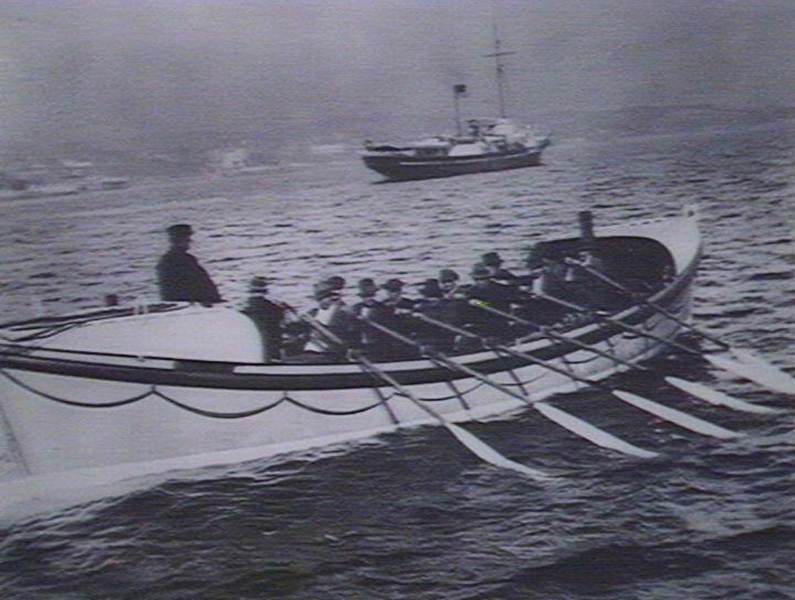
A lifeboat, circa 1895. image no. d1-19294h, courtesy State Library of NSW.
Barrenjoey-, Tuesday,10.50. At 4p.m on
Sunday, the pleasure boat Ada, from Sydney, sank off
Barrenjoey. One of the occupants
(Henry Tucker) was drowned, but his
body was recovered. The other gentlemen-Mr. Frank Smith, Mr.
Walker, and. Mr, Williams were rescued by the
Customs boat. The inquest on the body of Tucker is now
proceeding. TELEGRAPHIC INTELLIGENCE. (1871, December 27).
Empire(Sydney, NSW : 1850 - 1875), p. 3. Retrieved July 12, 2013, from http://nla.gov.au/nla.news-article60879495
BARRANJUIE LIGHTHOUSE. TO THE EDITOR OF THE
HERALD.
Sir,-I was rather surprised to find in the Herald of Saturday, a
communication wherein " George Mulhall, jun," contradicts
the sworn evidence of myself J. Walker, and G. Williams, given at the
inquest held on the body of the late Henry Tucker, to the effect that up till
quite dark on the night in question and we were not within two miles of the
land, so that if the lights had been there, we must have seen
them.
They were anxiously looked for, our position being a most
critical one, as we had either to risk running among the breakers on shore, or
standing out to sea in a small boat on a "dark night", in a fresh southerly
wind. I have spoken to some one experienced yachtsman, who entered Broken Bay
the same night; he confirms our statement as to there being no light
visible up till 9 o'clock'. I am convinced that Mr. Mulhall will fail
to bring any evidence to the contrary. We did not expect to see any light from
where we were camped. As this is a matter of the greatest importance, I trust
that the proper authorities will cause a strict investigation-to be made, and
not rest satisfied with the simple denial of Mr. Mulhall.
I remain, Sir,
your obedient servant,
FRANK
SMITH.
BARRANJUIE LIGHTHOUSE. (1872, January
2). The Sydney Morning Herald (NSW : 1842 - 1954), p. 2.
Retrieved July 12, 2013, from http://nla.gov.au/nla.news-article28416937
On the 15th of July 1877, in yet another south-east gale, the wrecking of the paddle steamer Yarra Yarra at Newcastle, which many bore witness to, caused right minded people to begin to look after those left on shore. The National Shipwreck Relief Society of New South Wales (later the Royal Shipwreck Relief & Humane Society of New South Wales) was founded in 1877 'for the relief of the widows, orphans and others dependent upon men lost in the marine service of our coast, or elsewhere, such relief to be distributed at the discretion of the Committee'. In 1902 it became the Royal Shipwreck Relief & Humane Society of New South Wales, and in 1968 it was re-named the Royal Humane Society of New South Wales. Medals and certificates were given to those who saved lives.
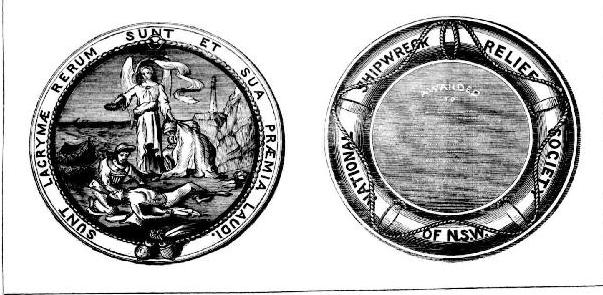 THE
NATIONAL SHIPWRECK SOCIETY'S MEDAL. The National Shipwreck Society's
Medal.
THE
NATIONAL SHIPWRECK SOCIETY'S MEDAL. The National Shipwreck Society's
Medal.
RECENTLY the National Shipwreck Society solicited competitive designs
for a medal distinctive of the society, for presentation in recognition of acts
of bravery and saving of life at sea. A goodly number of artistic designs were
forwarded by competitors, and, after due consideration, the committee decided to
adopt the design of Mr. James F. Sayers, manager of the London Chartered Bank at
Newcastle, and award the prize to that gentleman. The design, as may be seen
from an engraving, represents in a spirited manner a life-boat putting off for a
shipwrecked vessel. Lying on the shore is a man saved from a watery grave, his
rescuer using means to restore animation. Over the latter is an angel resting
one hand on the shoulders of a weeping mother with a babe in her arms; the other
containing a wreath, which is held towards the rescuer. The other side has the
name of the society, a space in the centre being left for the name of the
recipient and the deed that is recognised. The National Shipwreck
Society's Medal. (1878, August 24).Australian Town and
Country Journal (NSW : 1870 - 1907), p. 32. Retrieved from http://nla.gov.au/nla.news-article70594306
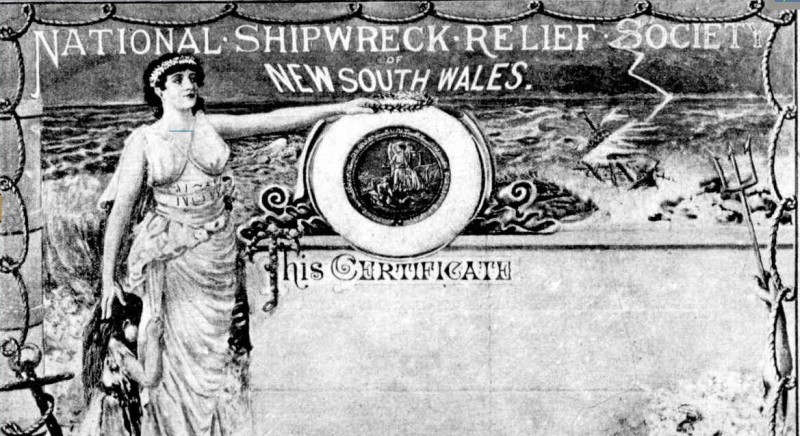
The head, neck, shoulder, arm, and other portions of the remains of apparently a youth about 17, were found recently in the stomach of a shark caught at Barrenjoey, New South Wales. The remains are believed to be those of the cabin boy drowned in the collision of the Barrabool and the Bonnie Dundee. The Sydney Marine Board have concluded the inquiry in the late collision case of the Barrabool and the Bonnie Dundee. They exonerated the captain of the Bonnie Dundee, and adjudged the mate in default. The latter had his certificate suspended for twelve months. Facts V Scraps. (1879, April 12). The Australasian Sketcher with Pen and Pencil (Melbourne, Vic. : 1873 - 1889), p. 11. Retrieved July 12, 2013, from http://nla.gov.au/nla.news-article60623206
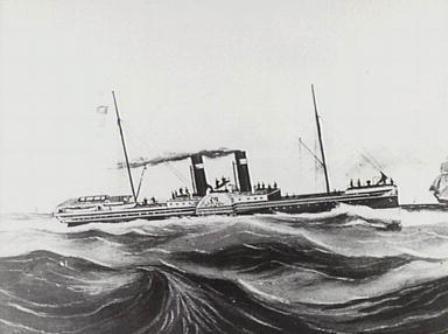 COLLISION BETWEEN TWO STEAMERS. (BY SPECIAL WIRE.) (FROM OUR
OWN CORRESPONDENT.) SYDNEY, THURSDAY.
COLLISION BETWEEN TWO STEAMERS. (BY SPECIAL WIRE.) (FROM OUR
OWN CORRESPONDENT.) SYDNEY, THURSDAY.
Between 2 and 3 o'clock this morning, a
serious collision occurred at sea between the Newcastle Steamship Company's
Steamer Kembla, and a Steamer of which the name is unknown, The
starboard paddle-box of the Kembla was smashed to splinters, and one of her
boats stove in, The delay necessary for examination and repairs causd the Kembla
to be very late on arriving at the wharf this morning. The passengers describe
the shock of the collision as very great, but there was no confusion on board.
The worst feature of the affair is that the steamer which ran into the Kembla
did not offer the least assistance, nor wait to see what damage the Newcastle
boat had sustained, but went away north. The name of the steamer is
supposed to be the City of Grafton, but some persons on board the Kembla were
under the impression that it was the Rosedale. The statement of the
captain of the Kembla, who was on deck at the time of the collision, ¡s as
follows :-" The Steamer Kembla left Newcastle last night with a full complement
of cargo and passengers. All went well until about 20 minutes past 2 this
morning. After passing Terrigal, and when Broken Bay light had opened well out,
a steamer's mast-head light was seen three or four points on our starboard bow,
apparently going well inside of us. Suddenly she ported her helm, showiog her
red light, and at the same time another steamer, almost on our starboard beam,
showed her masthead and red light, I watched this boat, and found she was
steering to northward, that is, going the same way as ourselves, and that we
were passing her fast by the Broken Bay light. By this time the boat first seen
was approaching close, and to clear her I ported a little, when the boat that
was steering south suddenly altered her coarse, and I found she was sheering up
alongside. I star-boarded to clear her at the risk of going too near the other
steamer, and called out, ' Where are you coming to ?'Shortly after she struck us
on the after part of the starboard sponson, cutting the beams and paddlebox to
pieces. I stopped and hailed, but receiving no answer, lowered a boat, and was
going to see if she required assistance, but she was noticed to steam away north
without stopping or answering. After securing the broken sponsons with derricks,
&c, I proceeded at half speed, and arrived at half-past 7 all well, I don't
know what boat it was,"
LATER,
It was
the steamer Rosedale which came into collision with the Kembla off Broken Bay at
half-past 2 this morning. The Rosedale had her bow plate stove in, but
reached Newcastle safely this morning. She leaves again for the north to-night.
Her captain is very reticent regarding the cause of the accident.
COLLISION BETWEEN TWO STEAMERS. (1883, January 12).The
Argus (Melbourne, Vic. : 1848 - 1957), p. 6. Retrieved from http://nla.gov.au/nla.news-article8489946
Whilst the ketch Favourite was on her voyage to Cape Hawke, yesterday, she met with very heavy weather, and a man was washed overboard. No attempt was made to save him, in consequence of the heavy sea causing the ballast to shift. The vessel had to put in to Barrenjoey. LATEST TELEGRAPHIC NEWS. (1885, March 3). Clarence and Richmond Examiner and New England Advertiser (Grafton, NSW : 1859 - 1889), p. 2. Retrieved July 12, 2013, from http://nla.gov.au/nla.news-article62146690
A Boating Accident. Barrenjoey, Tuesday.— A pleasure boat, having on board several members of the Orpheus Club, including Mr. Johnson (secretary) and another gentlemen, capsized on Monday evening in Pittwater. Fortunately some fishermen — by named, Strongman, Webster, Edwards, and others — saw the accident. They quickly put off and succeeded in rescuing all the party, none of whom (excepting Mr. Elwin, of Dubbo) were much the worse for their immersion. Mr. Elwin, on landing, received every attention from F. Jackson of the yacht Violet, and by the evening he had fully recovered. A Boating Accident. (1888, October 9). Evening News (Sydney, NSW : 1869 - 1931), p. 5. Retrieved from http://nla.gov.au/nla.news-article108113588
LOSS OF A
HULK. The Gem Sunk Off Barrenjoey Two Men Drowned.
The tug
Stormcock, which arrived here early this morning, brought news of a sad fatality
that took place off Barrenjoey at about 2 a.m. The tug left Newcastle
last night for Sydney with. Captain Jas. Donnelly in command. She had in tow the
hulk Gem; on board of which were Captain Hall, Tierney (mate)Thos.
Holmes (deck hand), and Emil Larson (caretaker), Mrs Larsen and a son, aged 9,
and three daughters, aged 7, 3, and 1 respectively. The vessel had a pretty
rough time during the night, and as Sydney was neared a heavy S.S.E. gale, with
high seas, came up. The hulk shipped a great deal of water, and when
about four miles off Barrenjoey Larsen came down to the cabin and told
his wife to collect what valuables she had and give them into his care. She did
so, and shortly after came on deck, when to her horror she saw her husband and
Holmes washed overboard. By some means the tug was communicated with, and
Captain Donnelly, backing up to the hulk, took off the rest of the people the
Gem sinking soon after. The Gem made a start from Newcastle on Sunday morning
last but had to put back owing to the weather. At 6 o'clock last evening she is
said to have been swept by several seas. The coal on board the hulk was being
shipped to Sydney for the R.M.S. Mariposa. Mrs. Larsen is left perfectly
destitute, and in addition to the children with her she has another son and
daughter in Sydney. Messrs. J. and A. Brown, the owners of the vessel, have
provided lodgings for her and family and Captain Webber, of the Shipwreck
Relief Society, is engaged in supplying clothes and other
necessaries. The deck hand Holmes leaves a widow, living at North Shore. The Gem
had been a barque before being used for a hulk, and is said to have been built
in the North of England. For sometime previous to coming to Newcastle she had
been used as a hulk at Brisbane. Owing to the heavy weather prevailing outside
the Heads, there is little prospect of the bodies of the unfortunate men being
found. LOSS OF A HULK. (1895, September 27). Evening
News(Sydney, NSW : 1869 - 1931), p. 6. Retrieved from http://nla.gov.au/nla.news-article109886553
We end this small list of vessels and incidents with a small insight into two shipwrecks that then gave their names to places, both to honour those who were lost and those who were saved, and on final wondering, as it always is when anyone discovers wreckage washed onto a shore:
MAITLAND GALE. Anniversary of Two Wrecks By
Illabo.
Forty-one years ago a great storm, now known as the Maitland Gale,
raged along the New South Wales coast. The gale continued for several days, but
during May 5-6,1898, the steamer Maitland and the ship Hereward were driven
ashore-the Maitland north of Sydney, and the Hereward to the south. The
Maitland, a steamer of 555 tons, was wrecked near Cape Three Points, a little
north of Broken Bay, 15 passengers and 11members of the crew being
drowned. The remainder of those on board were saved by means of a line most
gallantly taken ashore, and along which the people were hauled through the
breakers.
Some parts of the Maitland still remain near where the vessel was
wrecked. The scene is frequently visited by many hikers and others.
Maroubra
"Discovered."
In the same storm the ship Hereward was stranded at the
northern end of Maroubra Bay, south of Coogee. The wreck of the
Hereward was responsible for the "discovery" of what is now one of Sydney's most
popular surfing beaches. Until the time the Here-ward was driven ashore.
Maroubra was merely a name. Occasionally, before that period, a few venturesome
spirits would walk from Coogee over to Maroubra, but the only "permanents" were
employees of a wool scouring establishment at the northern end of the bay, near
where the vessel went ashore.
No lives were lost In the stranding of the
Hereward. The ship remained on the beach for some time, when a coffer dam was
built around it, and eventually the vessel was re-floated. While being towed
away, however, she was again driven ashore-on to the rocks in the bay-and later
broke up. The stranded ship attracted hundreds of people to Maroubra, which was
thus "placed on the map."
Illustrated: The Hereward fast on the beach at
Maroubra. Remains of the hull may still be
seen in the surf at low tide. MAITLAND GALE. (1939, May
6). The Sydney Morning Herald(NSW : 1842 - 1954), p. 13.
Retrieved from http://nla.gov.au/nla.news-article17568731
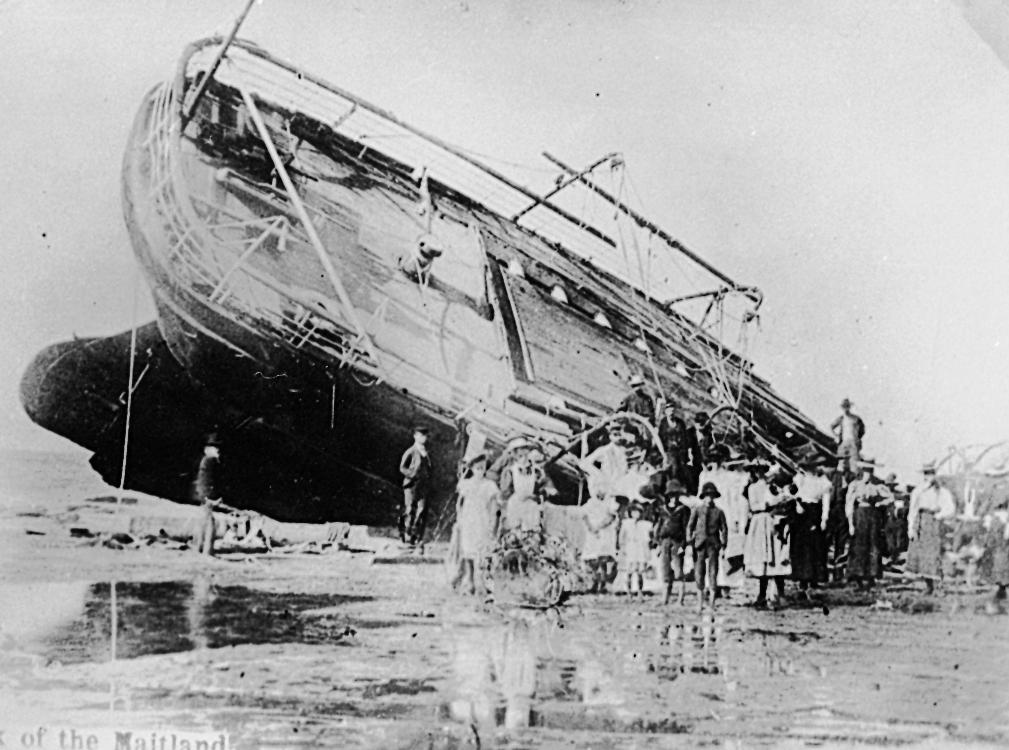
Above and Below: The wreck of the Maitland, May 5th, 1898 photo by Perier, image no perier 34615h, courtesy State Library of NSW,
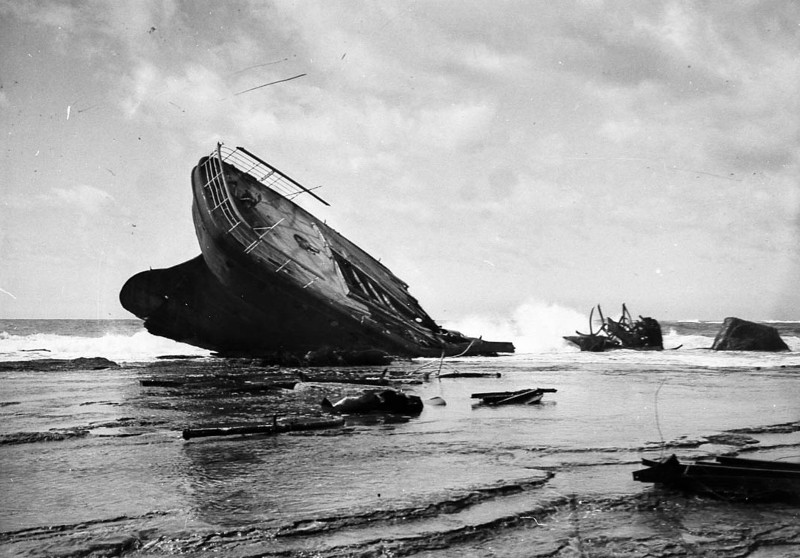
Last night, and several small crafts put back into Newcastle. The captain of the schooner Hannah Nicholson, which put into Barrenjoey this afternoon windbound, reports that eight miles to the Eastward she passed a large wreckage, consisting of half a boat, deck, planking, and part of a topmast and bulwarks, painted black and white. Telegraphic News. (1899, June 5). The North Queensland Register (Townsville, Qld. : 1892 - 1905), p. 10. Retrieved from http://nla.gov.au/nla.news-article84407685
References
1. John Palmer (Commissary of New South Wales). (2010, December 16). In Wikipedia, The Free Encyclopedia. Retrieved from http://en.wikipedia.org/w/index.php?title=John_Palmer_(Commissary_of_New_South_Wales)&oldid=402700850
2. HMS Sirius (1786). (2013, July 20). In Wikipedia, The Free
Encyclopedia. Retrieved from http://en.wikipedia.org/w/index.php?title=HMS_Sirius_(1786)&oldid=565008733
3. Australian Shipwrecks - vol 1 1622-1850, Charles Bateson, AH and AW
Reed, Sydney, 1972, ISBN 0-589-07112-2 p45
4. Encyclopaedia of Australian
Shipwrecks
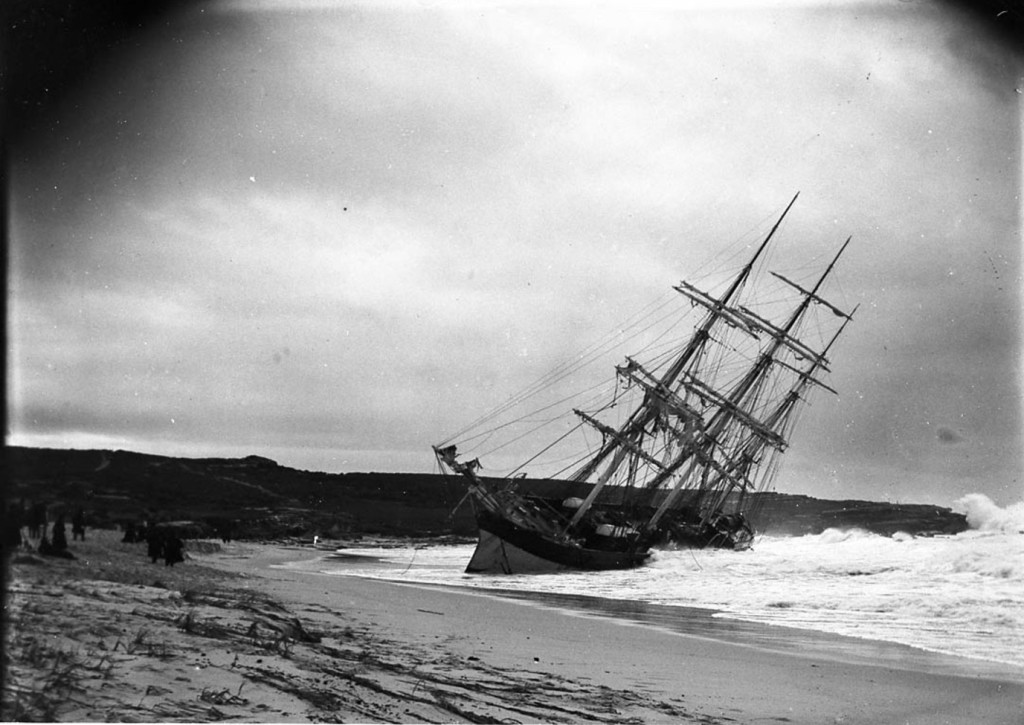
The Hereward on Maroubra Beach - her wreck and the subsequent visitors, Digital Order No. perier 34611h, courtesy State Library of NSW.
Barrenjoey Lighthouse - The Shipwrecks threads collected by A J Guesdon, 2013.